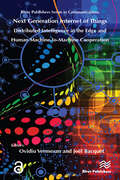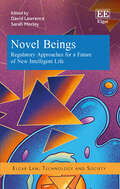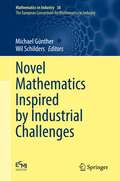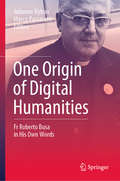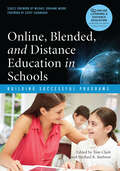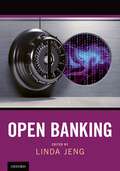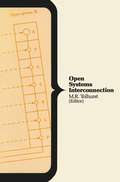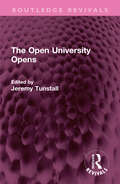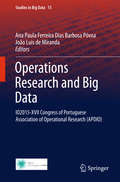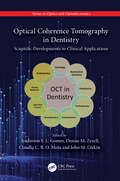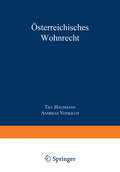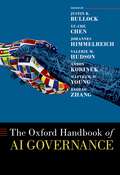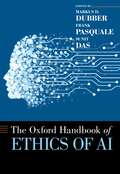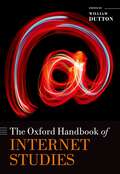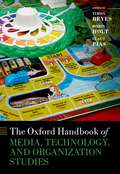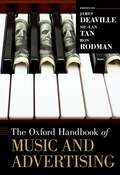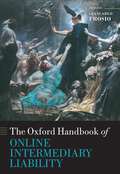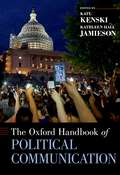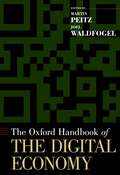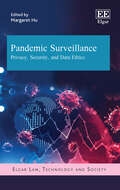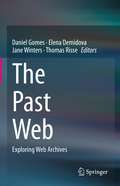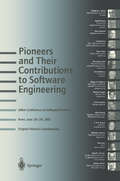- Table View
- List View
Next Generation Internet of Things – Distributed Intelligence at the Edge and Human-Machine Interactions
This book provides an overview of the next generation Internet of Things (IoT), ranging from research, innovation, development priorities, to enabling technologies in a global context. It is intended as a standalone in a series covering the activities of the Internet of Things European Research Cluster (IERC), including research, technological innovation, validation, and deployment.The following chapters build on the ideas put forward by the European Research Cluster, the IoT European Platform Initiative (IoT–EPI), the IoT European Large-Scale Pilots Programme and the IoT European Security and Privacy Projects, presenting global views and state-of-the-art results regarding the next generation of IoT research, innovation, development, and deployment.The IoT and Industrial Internet of Things (IIoT) are evolving towards the next generation of Tactile IoT/IIoT, bringing together hyperconnectivity (5G and beyond), edge computing, Distributed Ledger Technologies (DLTs), virtual/ andaugmented reality (VR/AR), and artificial intelligence (AI) transformation.Following the wider adoption of consumer IoT, the next generation of IoT/IIoT innovation for business is driven by industries, addressing interoperability issues and providing new end-to-end security solutions to face continuous treats.The advances of AI technology in vision, speech recognition, natural language processing and dialog are enabling the development of end-to-end intelligent systems encapsulating multiple technologies, delivering services in real-time using limited resources. These developments are focusing on designing and delivering embedded and hierarchical AI solutions in IoT/IIoT, edge computing, using distributed architectures, DLTs platforms and distributed end-to-end security, which provide real-time decisions using less data and computational resources, while accessing each type of resource in a way that enhances the accuracy and performance of models in the various IoT/IIoT applications.The convergence and combination of IoT, AI and other related technologies to derive insights, decisions and revenue from sensor data provide new business models and sources of monetization. Meanwhile, scalable, IoT-enabled applications have become part of larger business objectives, enabling digital transformation with a focus on new services and applications.Serving the next generation of Tactile IoT/IIoT real-time use cases over 5G and Network Slicing technology is essential for consumer and industrial applications and support reducing operational costs, increasing efficiency and leveraging additional capabilities for real-time autonomous systems.New IoT distributed architectures, combined with system-level architectures for edge/fog computing, are evolving IoT platforms, including AI and DLTs, with embedded intelligence into the hyperconnectivity infrastructure.The next generation of IoT/IIoT technologies are highly transformational, enabling innovation at scale, and autonomous decision-making in various application domains such as healthcare, smart homes, smart buildings, smart cities, energy, agriculture, transportation and autonomous vehicles, the military, logistics and supply chain, retail and wholesale, manufacturing, mining and oil and gas.
Novel Beings: Regulatory Approaches for a Future of New Intelligent Life (Elgar Law, Technology and Society series)
Novel Beings is a forward-looking exploration into the divide between proactive and reactive regulatory approaches to the cross-section of biotechnology and artificial intelligence (AI) research. Addressing an innovative area of academic study, Novel Beings questions how this research, which has the potential to create new forms of morally valuable life, could be regulated. This fascinating book examines the promises and perils of conflicting approaches to regulating emerging technologies in the unique context of this probable challenge for law and society. An impressive, and multidisciplinary, selection of expert contributors offer considerations vital to any attempt to address these issues before they become impossible to prevent or rectify. Chapters explore technologies such as genomics, synthetic biology and neurotechnologies, as well the profusion of ‘expert systems’ – algorithms and simple AI that interweave through everyday life, from smart assistants, to the financial markets, to social media. David Lawrence and Sarah Morley also discuss the global challenges for society and the laws regarding the status of these technological beings, their protections and obligations.This book will appeal to researchers and academics who are interested in the regulation of emerging technology. It will also provide a beneficial new resource for scholars and postgraduate students studying emerging technology in different fields, such as law, bioethics and philosophy.
Novel Mathematics Inspired by Industrial Challenges (Mathematics in Industry #38)
This contributed volume convenes a rich selection of works with a focus on innovative mathematical methods with applications in real-world, industrial problems. Studies included in this book are all motivated by a relevant industrial challenge, and demonstrate that mathematics for industry can be extremely rewarding, leading to new mathematical methods and sometimes even to entirely new fields within mathematics.The book is organized into two parts: Computational Sciences and Engineering, and Data Analysis and Finance. In every chapter, readers will find a brief description of why such work fits into this volume; an explanation on which industrial challenges have been instrumental for their inspiration; and which methods have been developed as a result. All these contribute to a greater unity of the text, benefiting not only practitioners and professionals seeking information on novel techniques but also graduate students in applied mathematics, engineering, and related fields.
Öffentliche Kunst, Kunst im öffentlichen Raum Niederösterreich, Band 8: / Public Art Lower Austria, Volume 8 (Veröffentlichte Kunst. Kunst im öffentlichen Raum Niederösterreich Public Art Lower Austria #8)
Kunst im öffentlichen Raum in Niederösterreich ist ein einzigartiges Modell, das international höchste Anerkennung findet. Die im ländlichen und kleinstädtischen Raum entstandenen Projekte bedeutender, aber auch junger unbekannter KünstlerInnen setzen sich mit der Landschaft, der Kulturgeschichte und der Architektur auseinander oder entstanden auf der Basis von sozialer und wissenschaftlicher Recherche. Der vorliegende Band dokumentiert die Projekte der Jahre 2004 – 2006. Neben der Projektdokumentation äußern sich Experten unterschiedlichster Bereiche in einer kunstwissenschaftlichen und theoretischen Diskussion zur "Gestaltung von Kreisverkehren", ein Thema brisanter Aktualität in der Gestaltung von Landschaft und Umgebung.
One Origin of Digital Humanities: Fr Roberto Busa in His Own Words
This book gathers, and makes available in English, with new introductions, previously out of print or otherwise difficult to access articles by Fr Roberto Busa S.J. (1913 - 2011). Also included is a comprehensive bibliography of Busa, an oral history interview with Busa's translator, and a substantial new chapter that evaluates Busa's contributions and intellectual legacies. The result is a groundbreaking book that is of interest to digital humanists and computational linguists as well as historians of science, technology and the humanities. As the application of computing to cultural heritage becomes ever more ubiquitous, new possibilities for transmitting, shaping, understanding, questioning and even imagining the human record are opening up. Busa is considered by many to be among the pioneers in this field, and his research on projects like the Index Thomisticus is one of the earliest known examples of a humanities project that incorporated automation; it continues to be widely cited and used today. Busa published more than 350 academic articles and shorter pieces in numerous languages, but despite the unquestionable importance of his early work for understanding the history and development of fields like humanities computing and computational linguistics, a large part of his canon and thinking remained inaccessible or difficult to access until this book.
Online, Blended, and Distance Education in Schools: Building Successful Programs
Co-Published with the Microsoft Corporation Online, Blended and Distance Education in Schools provides students enrolled in Education Technology, Educational Administration and related Masters and PhD programs with expert opinions and insights on the practice and policy in K-12 online, blended and distance education, online and blended programs, including curriculum, instruction, technology and management aspects. It describes the status and trends of the field, provides illustrative program examples, explores the issues and challenges that programs face and highlights ongoing research in key areas related to program effectiveness. Topics discussed:* The current status of K-12 online, distance and blended learning in the U.S.* Policy, funding, and management issues in relation to program implementation* Research on effective programs within governmental jurisdiction and various program types* Global case studies that represent the variety of ways programs are being successfully implemented * A synthesis of key findings and lessons learned, and local and global visions for the future of K-12 distance and online learningThis text is highly appropriate for students enrolled in Educational Technology, Educational Administration and related Masters and PhD programs. An online companion resource provides pedagogical features that enhance text use in a classroom setting.
Open Banking
Open banking is a silent revolution transforming the banking industry. It is the manifestation of the revolution of consumer technology in banking and will dramatically change not only how we bank, but also the world of finance and how we interact with it. Since the United Kingdom along with the rest of the European Union adopted rules requiring banks to share customer data to improve competition in the banking sector, a wave of countries from Asia to Africa to the Americas have adopted various forms of their own open banking regimes. Among Basel Committee jurisdictions, at least fifteen jurisdictions have some form of open banking, and this number does not even include the many jurisdictions outside the Basel Committee membership with open banking activities. Although U.S. banks and market participants have been sharing customer-permissioned data for the past twenty years and there have been recent policy discussions, such as the Obama administration's failed Consumer Data Privacy Bill and the Data Aggregation Principles of the Consumer Financial Protection Bureau, open banking is still a little-known concept among consumers and policymakers in the States. This book defines the concept of 'open banking' and explores key legal, policy, and economic questions raised by open banking.
Open Systems Interconnection (Computer Science Series)
Written by a team of software engineers at Admiral Computing Group, this book will appeal both to students of computer systems and to practising engineers. It provides a comprehensive overview of the OSI model and its layers.
The Open University Opens (Routledge Revivals)
Still going strong today, The Open University, Britain’s national correspondence – TV – radio University, excited much controversy when it first opened and in 1973 awarded its first degrees. With its adult, part-time students, its freedom from formal entrance qualifications, it deliberately questioned many orthodoxies of higher education at the time. Yet the OU differed so much from other universities that few outsiders grasped quite how complex, quite how revolutionary, quite how downright infuriating the OU was, or could be.Originally published in 1974, this book gives a first-hand account of what the OU was about and what it felt like to be an OU student or lecturer. The articles in the collection – edited by Jeremy Tunstall, himself on the OU staff – include contributions from outside observers, from OU staff, and from OU students. This is an unofficial yet informed and lively account of what it felt like in 1974, and what it felt like in the early days, to be part of a project so controversial and progressive.
Operations Research and Big Data: IO2015-XVII Congress of Portuguese Association of Operational Research (APDIO) (Studies in Big Data #15)
The development of Operations Research (OR) requires constant improvements, such as the integration of research results with business applications and innovative educational practice. The full deployment and commercial exploitation of goods and services generally need the construction of strong synergies between educational institutions and businesses. The IO2015 -XVII Congress of APDIO aims at strengthening the knowledge triangle in education, research and innovation, in order to maximize the contribution of OR for sustainable growth, the promoting of a knowledge-based economy, and the smart use of finite resources. The IO2015-XVII Congress of APDIO is a privileged meeting point for the promotion and dissemination of OR and related disciplines, through the exchange of ideas among teachers, researchers, students , and professionals with different background, but all sharing a common desire that is the development of OR.
Optical Coherence Tomography in Dentistry: Scientific Developments to Clinical Applications (Series in Optics and Optoelectronics)
Optical Coherence Tomography (OCT), a method to "see inside of things" without destroying them, has been applied to subjects ranging from materials science to medicine. This book focuses on the biomedical application of OCT in dentistry, covering topics from dental materials to clinical practice. Since the introduction of the OCT method in ophthalmology in 1991, and then dentistry in 1998, developments in OCT methods, particularly in biomedical areas, have led to its dissemination worldwide. The chapters of this book cover the basics and recent global advances of OCT in dentistry, including an overview of the method and its use in cariology, restorative dentistry, dental materials, endodontics, pediatric dentistry, orthodontics, prosthodontics, soft oral tissues and nanodentistry. This book will be of interest to both newcomers in the field as well as those already working in OCT, either in research and/or the clinic. It will be of great use in courses on optical imaging applied to biomedical areas, particularly where it can provide real-life examples of the application of OCT.
The Oxford Handbook of AI Governance (Oxford Handbooks)
As the capabilities of Artificial Intelligence (AI) have increased over recent years, so have the challenges of how to govern its usage. Consequently, prominent stakeholders across academia, government, industry, and civil society have called for states to devise and deploy principles, innovative policies, and best practices to regulate and oversee these increasingly powerful AI tools. Developing a robust AI governance system requires extensive collective efforts throughout the world. It also raises old questions of politics, democracy, and administration, but with the new challenges posed by AI's growing influence on markets, governing structures, international relations, healthcare, science, and political activism. The Oxford Handbook of AI Governance delineates the scope of these issues and addresses the key questions of AI governance. Across forty-nine chapters, organized in nine major sections, the Handbook covers the theoretical and ethical foundations of AI governance, different frameworks for developing a governance structure for AI, practical perspectives on AI governance in different policy domains, economic analyses of AI governance, and concrete lessons about the impact of AI governance domestically and internationally. Chapter authors come from a wide set of disciplines, areas of study, and cultural backgrounds, providing a global perspective on AI governance.
The Oxford Handbook of Ethics of AI (Oxford Handbooks)
This volume tackles a quickly-evolving field of inquiry, mapping the existing discourse as part of a general attempt to place current developments in historical context; at the same time, breaking new ground in taking on novel subjects and pursuing fresh approaches. The term "A.I." is used to refer to a broad range of phenomena, from machine learning and data mining to artificial general intelligence. The recent advent of more sophisticated AI systems, which function with partial or full autonomy and are capable of tasks which require learning and 'intelligence', presents difficult ethical questions, and has drawn concerns from many quarters about individual and societal welfare, democratic decision-making, moral agency, and the prevention of harm. This work ranges from explorations of normative constraints on specific applications of machine learning algorithms today-in everyday medical practice, for instance-to reflections on the (potential) status of AI as a form of consciousness with attendant rights and duties and, more generally still, on the conceptual terms and frameworks necessarily to understand tasks requiring intelligence, whether "human" or "A.I."
The Oxford Handbook of Internet Studies (Oxford Handbooks)
Internet Studies has been one of the most dynamic and rapidly expanding interdisciplinary fields to emerge over the last decade. The Oxford Handbook of Internet Studies has been designed to provide a valuable resource for academics and students in this area, bringing together leading scholarly perspectives on how the Internet has been studied and how the research agenda should be pursued in the future. The Handbook aims to focus on Internet Studies as an emerging field, each chapter seeking to provide a synthesis and critical assessment of the research in a particular area. Topics covered include social perspectives on the technology of the Internet, its role in everyday life and work, implications for communication, power, and influence, and the governance and regulation of the Internet. The Handbook is a landmark in this new interdisciplinary field, not only helping to strengthen research on the key questions, but also shape research, policy, and practice across many disciplines that are finding the Internet and its political, economic, cultural, and other societal implications increasingly central to their own key areas of inquiry.
The Oxford Handbook of Media, Technology, and Organization Studies (Oxford Handbooks)
Our most basic relationship with the world is one of technological mediation. Nowadays our available tools are digital, and increasingly what counts in economic, social, and cultural life is what can be digitally stored, distributed, replayed, augmented, and switched. Yet the digital remains very much materially configured, and though it now permeates nearly all human life it has not eclipsed all older technologies. This Handbook is grounded in an understanding that our technologically mediated condition is a condition of organization. It maps and theorizes the largely unchartered territory of media, technology, and organization studies. Written by scholars of organization and theorists of media and technology, the chapters focus on specific, and specifically mediating, objects that shape the practices, processes, and effects of organization. It is in this spirit that each chapter focuses on a specific technological object, such as the Battery, Clock, High Heels, Container, or Smartphone, asking the question, how does this object or process organize? In staying with the object the chapters remain committed to the everyday, empirical world, rather than being confined to established disciplinary concerns and theoretical developments. As the first sustained and systematic interrogation of the relation between technologies, media, and organization, this Handbook consolidates, deepens, and further develops the empirics and concepts required to make sense of the material forces of organization.
The Oxford Handbook of Music and Advertising (Oxford Handbooks)
The Oxford Handbook of Music and Advertising is an essential guide to the crucial role that music plays in relation to the audio or audiovisual advertising message, from the perspectives of its creation, interpretation, and reception. The book's unique three-part organization reflects this life cycle of an advertisement, from industry inception to mass-mediated text to consumer behaviour. Experts well versed in the practice, analysis, and empirical studies of the commercial message have contributed to the collection's forty-two chapters, which collectively represent the most ambitious and comprehensive attempt to date to address the important intersections of music and advertising. Handbook chapters are self-contained yet share borders with other contributions within a given section and across the major sections of the book, so readers can either study one topic of particular interest or read through to gain an understanding of the broader issues at stake. Within the book's Introduction, each editor has provided an overview of the unifying themes for the section for which they were responsible, with brief summaries of individual contributions at the beginnings of the sections. The lists of recommended readings at the end of chapters are intended to assist readers in finding further literature about the topic. An overview of industry practices by a music insider is provided in the Appendix, giving context for the three parts of the book.
Oxford Handbook of Online Intermediary Liability (Oxford Handbooks)
To better understand the heterogeneity of the international online intermediary liability regime, The Oxford Handbook of Intermediary Liability Online is designed to provide a comprehensive, authoritative and 'state-of-the-art' discussion of by highlighting emerging trends. This book discusses fundamental legal issues in intermediary liability online, while also describing advancement in intermediary liability theory and identifying recent policy trends. Sections I and II provide a taxonomy of internet platforms, a general discussion of possible basis for liability and remedies, while putting into context intermediary liability regulation with fundamental rights and the ethical implications of the intermediaries' role. Section III presents a jurisdictional overview discussing intermediary liability safe harbour arrangements and highlighting issues with systemic fragmentation and miscellaneous inconsistent approaches. Mapping online intermediary liability worldwide entails the review of a wide-ranging topic, stretching into many different areas of law and domain-specific solutions. Section IV provides an overview of intermediate liability for copyright, trademark, and privacy infringement, together with Internet platforms' obligations and liabilities for defamation, hate and dangerous speech. Section V reviews intermediary liability enforcement strategies by focusing on emerging trends, including proactive monitoring obligations across the entire spectrum of intermediary liability subject matters, blocking orders against innocent third parties, and the emergence of administrative enforcement of intermediary liability online. In addition, Section VI discusses an additional core emerging trend in intermediary liability enforcement: voluntary measures and private ordering. Finally, international private law issues are addressed in Section VII with special emphasis on the international struggle over Internet jurisdiction and extra-territorial enforcement of intermediaries' obligations.
The Oxford Handbook of Political Communication (Oxford Handbooks)
Since its development shaped by the turmoil of the World Wars and suspicion of new technologies such as film and radio, political communication has become a hybrid field largely devoted to connecting the dots among political rhetoric, politicians and leaders, voters' opinions, and media exposure to better understand how any one aspect can affect the others. In The Oxford Handbook of Political Communication Kate Kenski and Kathleen Hall Jamieson bring together leading scholars, including founders of the field of political communication Elihu Katz, Jay Blumler, Doris Graber, Max McCombs, and Thomas Paterson,to review the major findings about subjects ranging from the effects of political advertising and debates and understandings and misunderstandings of agenda setting, framing, and cultivation to the changing contours of social media use in politics and the functions of the press in a democratic system. The essays in this volume reveal that political communication is a hybrid field with complex ancestry, permeable boundaries, and interests that overlap with those of related fields such as political sociology, public opinion, rhetoric, neuroscience, and the new hybrid on the quad, media psychology. This comprehensive review of the political communication literature is an indispensible reference for scholars and students interested in the study of how, why, when, and with what effect humans make sense of symbolic exchanges about sharing and shared power. The sixty-two chapters in The Oxford Handbook of Political Communication contain an overview of past scholarship while providing critical reflection of its relevance in a changing media landscape and offering agendas for future research and innovation.
The Oxford Handbook of the Digital Economy (Oxford Handbooks)
The economic analysis of the digital economy has been a rapidly developing research area for more than a decade. Through authoritative examination by leading scholars, this handbook takes a closer look at particular industries, business practices, and policy issues associated with the digital industry. The volume offers an up-to-date account of key topics, discusses open questions, and provides guidance for future research. It offers a blend of theoretical and empirical works that are central to understanding the digital economy. The chapters are presented in four sections, corresponding with four broad themes: 1) infrastructure, standards, and platforms; 2) the transformation of selling, encompassing both the transformation of traditional selling and new, widespread application of tools such as auctions; 3) user-generated content; and 4) threats in the new digital environment. The first section covers infrastructure, standards, and various platform industries that rely heavily on recent developments in electronic data storage and transmission, including software, video games, payment systems, mobile telecommunications, and B2B commerce. The second section takes account of the reduced costs of online retailing that threatens offline retailers, widespread availability of information as it affects pricing and advertising, digital technology as it allows the widespread employment of novel price and non-price strategies (bundling, price discrimination), and auctions. The third section addresses the emergent phenomenon of user-generated content on the Internet, including the functioning of social networks and open source. The fourth section discusses threats arising from digitization and the Internet, namely digital piracy, privacy, and security concerns.
The Oxford Handbook of Video Game Music and Sound (Oxford Handbooks)
The music and sounds of video games have become an inescapable part of our world. Not only do these sonic elements profoundly shape the experiences of billions of players every day, but also the soundscapes of games have stretched out from our living rooms to encompass spaces as diverse as pinball arcades, concert halls, museums, and classrooms across the globe. Research on game music and sound is equally diverse-a vibrant, innovative, and multifaceted field that incorporates approaches from media studies, musicology, sound studies, music theory, psychology, and more. Drawing on the expertise of leading scholars and practitioners from around the globe, The Oxford Handbook of Video Game Music and Sound features nearly 50 chapters on topics ranging from the earliest pinball machines to the latest in virtual reality technology. The resulting volume provides both a comprehensive introduction to the study of game audio and an indispensable resource for experts.
Pandemic Surveillance: Privacy, Security, and Data Ethics (Elgar Law, Technology and Society series)
As the COVID-19 pandemic surged in 2020, questions of data privacy, cybersecurity, and ethics of the surveillance technologies centred an international conversation on the benefits and disadvantages of the appropriate uses and expansion of cyber surveillance and data tracking. This timely book examines and answers these important concerns.Pandemic Surveillance frames and defines digital privacy and security in the context of emerging surveillance technologies, providing informed dialogue on international conversations regarding pandemic surveillance. The book examines the challenges of regulating pandemic surveillance technologies across diverse geographical settings, including Europe and Latin America, along with comparative analysis of social credit systems in China and the United States. Margaret Hu and her impressive selection of contributors explore the legal, scientific and ethical challenges in a world with a growing data surveillance architecture, providing policy recommendations and forward-looking solutions, including the importance of ethical frameworks, to minimise potential misuse and abuse of surveillance technologies.Delivering a well-rounded examination of pandemic surveillance and data-tracking technologies, this book is a crucial read for researchers and scholars focused on information security and data privacy, including specialists in the area of cyber ethics and data ethics. Students and academics interested in health policy and bioethics will also benefit from the insights in this text.
Partnering with Online Program Managers for Distance Education: Approaches to Policy, Quality, and Leadership
Partnering with Online Program Managers for Distance Education offers fresh insights into the practice, implications, and outcomes of partnerships between higher education institutions and for-profit online program managers (OPMs). As colleges and universities race to build effective, sustainable distance education programs, higher education administrators often rely on third-party OPMs for marketing and student recruitment, student support from orientation to graduation, course design and delivery, and other fee-based services. This edited collection provides a global knowledge base for understanding academic quality, policy, and management in university-OPM partnerships along with actionable strategies and frameworks for selection, evaluation, and improvement. Leaders, administrators, developers, and accreditors of digital distance learning programs in higher education will come away with evidence-based guidance and realistic perspectives into the opportunities and challenges of this fast-emerging resource.
The Past Web: Exploring Web Archives
This book provides practical information about web archives, offers inspiring examples for web archivists, raises new challenges, and shares recent research results about access methods to explore information from the past preserved by web archives. The book is structured in six parts. Part 1 advocates for the importance of web archives to preserve our collective memory in the digital era, demonstrates the problem of web ephemera and shows how web archiving activities have been trying to address this challenge. Part 2 then focuses on different strategies for selecting web content to be preserved and on the media types that different web archives host. It provides an overview of efforts to address the preservation of web content as well as smaller-scale but high-quality collections of social media or audiovisual content. Next, Part 3 presents examples of initiatives to improve access to archived web information and provides an overview of access mechanisms for web archives designed to be used by humans or automatically accessed by machines. Part 4 presents research use cases for web archives. It also discusses how to engage more researchers in exploiting web archives and provides inspiring research studies performed using the exploration of web archives. Subsequently, Part 5 demonstrates that web archives should become crucial infrastructures for modern connected societies. It makes the case for developing web archives as research infrastructures and presents several inspiring examples of added-value services built on web archives. Lastly, Part 6 reflects on the evolution of the web and the sustainability of web archiving activities. It debates the requirements and challenges for web archives if they are to assume the responsibility of being societal infrastructures that enable the preservation of memory. This book targets academics and advanced professionals in a broad range of research areas such as digital humanities, social sciences, history, media studies and information or computer science. It also aims to fill the need for a scholarly overview to support lecturers who would like to introduce web archiving into their courses by offering an initial reference for students.
